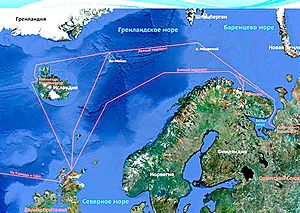Operation Doppelschlag facts for kids
Quick facts for kids Operation Doppelschlag |
|
|---|---|

Admiral Scheer, photographed in early 1942
|
|
| Type | Sortie |
| Location | Arctic Ocean |
| Planned | 1942 |
| Planned by | Kriegsmarine |
| Commanded by |
|
| Target | Convoy PQ 18 |
| Outcome | Cancelled |
Operation Doppelschlag (Operation Double Blow/Unternehmen Doppelschlag) was a German plan for a sortie in 1942 during the Second World War into the Arctic Ocean by the Kriegsmarine. The operation followed Operation Rösselsprung, against Convoy PQ 17 in July 1942 to attack convoy PQ 18 the next Arctic convoy of the Western Allies.
Contents
Background
Following the victory over Convoy PQ 17, the Kriegsmarine was keen to repeat the blow to assist German military operations. A plan was made to bring a strong force of capital ships and destroyers against the next supply convoy to destroy it. The commanders of the surface forces were disappointed they had been unable to take a more active part in the attack on PQ 17 and were determined to do better. The Allies wished to avoid running another convoy in the continuous daylight of the Arctic summer and deferred passage of PQ 18 until later in the year. The German forces spent over two months at readiness before PQ 18 sailed in early September 1942.
Plan

At first Doppelschlag resembled Rösselsprung in that the forces involved would wait in readiness at their bases until a convoy was detected, whilst a patrol line of U-boats (Wolfpack Ice Palace) was stationed in the Norwegian Sea to give early warning of a convoy. Once the convoy was detected the ships would sail north to Altafjord, to await the order to attack. The extreme sensitivity to the possibility of losing a capital ship in an engagement with the Allied fleet meant that only Hitler could give permission for the second stage, the sortie into the Barents Sea. Once out the ships would divide into two battle groups, to attack the convoy from different sides.
It was envisaged that the first group would engage and draw off any heavy units with the convoy, while the second would attack the merchant ships without serious opposition. It was this intended double blow that inspired the operational name. The forces intended to take part in the operation were the Admiral Scheer, Admiral Hipper, Köln and six destroyers. Other German capital ships based in Norway, Tirpitz and Lützow were not available for the operation as both had been under repair since the end of Rosselsprung.
Operation
PQ 18 sailed from Iceland on 7 September 1942. It was sighted on 8 September by a long-range aircraft and again on 10 September by an Ice Palace U-boat. On 10 September, the ships of operation Doppelschlag left harbour at Narvik to move north to Altenfjord. In this they were sighted by patrolling British submarines andTigris mounted an abortive attack. The ships arrived at Altenfjord early the following day. From this point the Doppelschlag commanders, Vice-Admiral Oskar Kummetz in Scheer, and Vice Admiral Otto Ciliax ashore, pressed for permission to sortie but Hitler's insistence that no damage should befall the ships so restricted their freedom of action that Admiral Erich Raeder, the Navy's supreme commander, cancelled the operation. Thus the attack on PQ 18 was left to the Luftwaffe and the U-boat arm.
Aftermath
The German surface fleet had little effect on the passage of PQ 18, though the potential threat it posed had forced the commitment of many Allied vessels as escort. The next opportunity for an attack by German surface ships would come in December, when Operation Regenbogen, following a similar plan to Doppelschlag, was mounted against Convoy JW 51B. This would result in the Battle of the Barents Sea.

